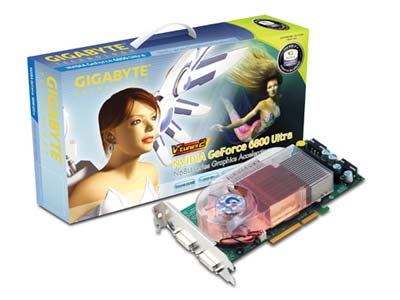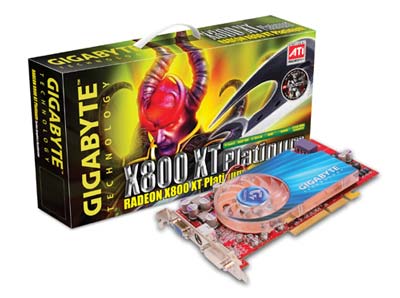Buyer's Guide: High End System - July 2004
by Wesley Fink on June 30, 2004 12:00 PM EST- Posted in
- Guides
Video
Recommendation: Gigabyte GV-N68U256D 256MB GeForce 6800 UltraPrice: $539 shipped

While the dust is still settling in this round of the video wars, we do know that the new generation of video cards from nVidia and ATI are twice as fast as the previous generation in many benchmarks. We also found in our testing of the new nVidia nForce3-250 chipset that it performs a bit better with an nVidia graphics card. With that in mind, we included a GeForce 6800 Ultra in our High End system to match the nForce3-250 Ultra-based MSI K8N Neo2.
While they are still all but impossible to find, you simply can't ignore the new cards when building a high end system. We ended up relaxing our rules by including the Gigabyte 6800 Ultra because several vendors are showing availability in the first 2 weeks of July. Several vendors are also showing prices closer to the $500 that we expect when cards are more readily available.
The 6800 Ultra features 16 pipelines, a GPU at 400MHz, and 256MB of DDR3 memory at 1.1GHz. It is a nice step up from the 12-pipe 6800 and the lower clocked 6800 GT, yet both of these 2 cards are still blazing performers, and are easier to find. There is also an even faster version of the 6800 family, called the 6800 Ultra Extreme, but as rare as 6800 Ultra cards are right now, we would hesitate to recommend an even rarer card, which is a higher-clocked 6800 Ultra. The best way to see what the 6800 Ultra can do is to read the latest AnandTech Video Card review, which compares ATI X800 and nVidia 6800 in both AGP and PCI Express flavors.
Alternative: Gigabyte GV-R80X256V 256MB X800 XT
Price: $545 shipped

If your prefer ATI video cards, there is only good to be said for the performance of the X800 XT. Once again, several vendors are promising Gigabyte products around July 7th for the X800 XT video cards, so that is our recommendation. On the basis of features and the future, the X800 XT should be considered the culmination of the series that began with the 9700 PRO; the 6800 Ultra should be considered the beginning of a new graphics chip series. Having said that, the chips perform almost exactly the same in our benchmarks, and the ATI is actually faster in a few benchmarks. This even performance between ATI and nVidia also extends to the PCI Express interface where the cards take different approaches to their interface to the PCI Express bus.
Our point is that you can choose either the X800 XT or the 6800 Ultra and be perfectly happy and perfectly competitive, although there are certainly differences beneath the hood that might sway you in one direction or the other. The ATI X800 XT would be an excellent match to either the Athlon 64 system or the Intel Pentium 4 system, and would perform very well on either platform.
If price for video is a concern, you can pare down quite a bit and still select a new generation video card. The basic 12-pipeline nVidia 6800 is available for about $300, while the 16-pipe 6800 GT and 12-pipe X800 PRO will cost about $400. The performance is pretty consistent with the price, although we do find the 6800 at $300 a very good value, particularly if you find one that overclocks well.
With the introduction of the new generation of video cards, there are also some real bargains available at what was the old high end. You can find either an nVidia GeForce 5900XT 128MB or an ATI 9800 PRO 128MB for around $200, but the 9800 PRO is generally regarded as the better performer in a comparison of these two cards. The 9800 XT and the comparable 5950 Ultra are still selling in the $370 range, which is a poor value compared to the nVidia 6800 at $300 or the 6800 GT or X800 PRO at $400.
We recommend that you stay away from the 9800SE video cards. With the 9800 PRO so reasonable these days, there is absolutely no reason to settle for a 9800SE that, at best, performs on par with or often even slower than a 9600 Pro in 3D games. Don't be fooled - a 9800SE performs nothing like a full-blown 8-pipe, 256 bit memory interface 9800 Pro.
Listed below is part of our RealTime pricing engine, which lists the lowest prices available on ATI video cards from many different reputable vendors:
If you cannot find the lowest prices on the products that we've recommended on this page, it's because we don't list some of them in our RealTime pricing engine. Until we do, we suggest that you do an independent search online at the various vendors' web sites. Just pick and choose where you want to buy your products by looking for a vendor located under the "Vendor" heading.










49 Comments
View All Comments
kd4yum - Thursday, July 8, 2004 - link
Well! I guess so!regarding comment 28....
Now wait a minute. Why would RAID 0 cut the MTBF in half? Is this dice we are rolling?
Probably, the splay of i/o across mult disks would relax the work on the actuator arms.
'specially if 'elevator queueing' is active.
And don't forget about reduced fragmentation.
No, I think you'd get your 100K hours with either RAID 0 or RAID 1. It would just hirt more with RAID 0. my $0.02
kd4yum - Thursday, July 8, 2004 - link
Let's see. Do I still have a valid uname and passwd? uhhhthe5thgeek - Wednesday, July 7, 2004 - link
Ok my bad, it is not on the U.S. version of the msi web site. thanks!Wesley Fink - Wednesday, July 7, 2004 - link
#32 -The board is definitely on MSI's web bite at http://www.msi.com.tw/program/support/download/dld...It even has BIOS and drivers posted. MSI assured us the board would be available beginning last week, so it should be available very soon.
#33 - There will be an Overclocking Guide later this month. With all of the massive changes in Sockets, Chipsets, and Hardware, we decided to delay the overclocking guide until the new hardware was released and could be tested.
lazerasa - Tuesday, July 6, 2004 - link
what happened to the overclock system buyers guide? there hasn't been one in 3 months...?the5thgeek - Tuesday, July 6, 2004 - link
Why are you recomending a motherboard that does not exist? (at least for us poor mortals that must deal in the real world[that board is not even on MSI's web site, much less available retail])warath - Sunday, July 4, 2004 - link
I find it funny that in one article you recommend RAID-0, and in another, you say NOT EVEN Close to worth it :P :) Make up your minds Anandtech!TrogdorJW - Thursday, July 1, 2004 - link
Regarding RAID 0, it really isn't as "useless" as the other article portrays, depending on what you do with it. If you only play games and surf the web, then it certainly isn't that big of a deal. If you routinely copy files around on your hard drive (i.e. either compressing or extracting from archives), or in compiling code, there is a somewhat noticeable improvement in speed. There is also a definite improvement in performance when multitasking with a hard-drive intense operation running in the background. For example, try copying a file from one drive to another drive while surfing the web with and without RAID 0. It's something I do periodically, and I definitely notice an improvement. Video editing definitely benefits from the added hard drive performance.Maybe it's not worth the extra cost, but I really don't like dealing with three hard drive letters much. I have one drive setup as my C: drive, and then two drives striped as drive D:. So I have a 320 GB D: partition and a 120 GB C: partition. The cost of the D: partition was about $230 - only slightly more than a single 74 GB Raptor. Of course, I don't store any critical files on the RAID 0 array - it's all stuff that I would only be moderately irritated at having to reinstall.
Z80 - Thursday, July 1, 2004 - link
Regarding the MSI motherboard recommendation:"A hardware and software service company from Vermont filed a legal class-action suit against Microstar International accusing one of the leading mainboard makers in the world of intentionally using low-quality components on its mainboards. A report from Reuters claims that the suit, filed in Los Angeles Superior Court last Thursday by Electronic Connection Services Corporation claims that MSI has knowingly used capacitors, devices used to regulate the power supply to microchips, that can leak or even explode and cause mainboards to short-circuit. The suit, which seeks to cover any person or company in the United States who has made a wholesale or retail purchase of an MSI mainboard since 1999, seeks unspecified damages and restitution and other relief."
I wonder if I can get any money back for those two crappy MSI MB's I got stuck with!
qooleot - Thursday, July 1, 2004 - link
Ya..I was gonna say the same thing...In one article today you guys write:
If you haven't gotten the hint by now, we'll spell it out for you: there is no place, and no need for a RAID-0 array on a desktop computer. The real world performance increases are negligible at best and the reduction in reliability, thanks to a halving of the mean time between failure, makes RAID-0 far from worth it on the desktop.
And in another article:
Recommended: Dual Western Digital Raptor 74GB 10,000RPM SATA in RAID 0 Configuration
I guess you guys haven't gotten the hint by now...